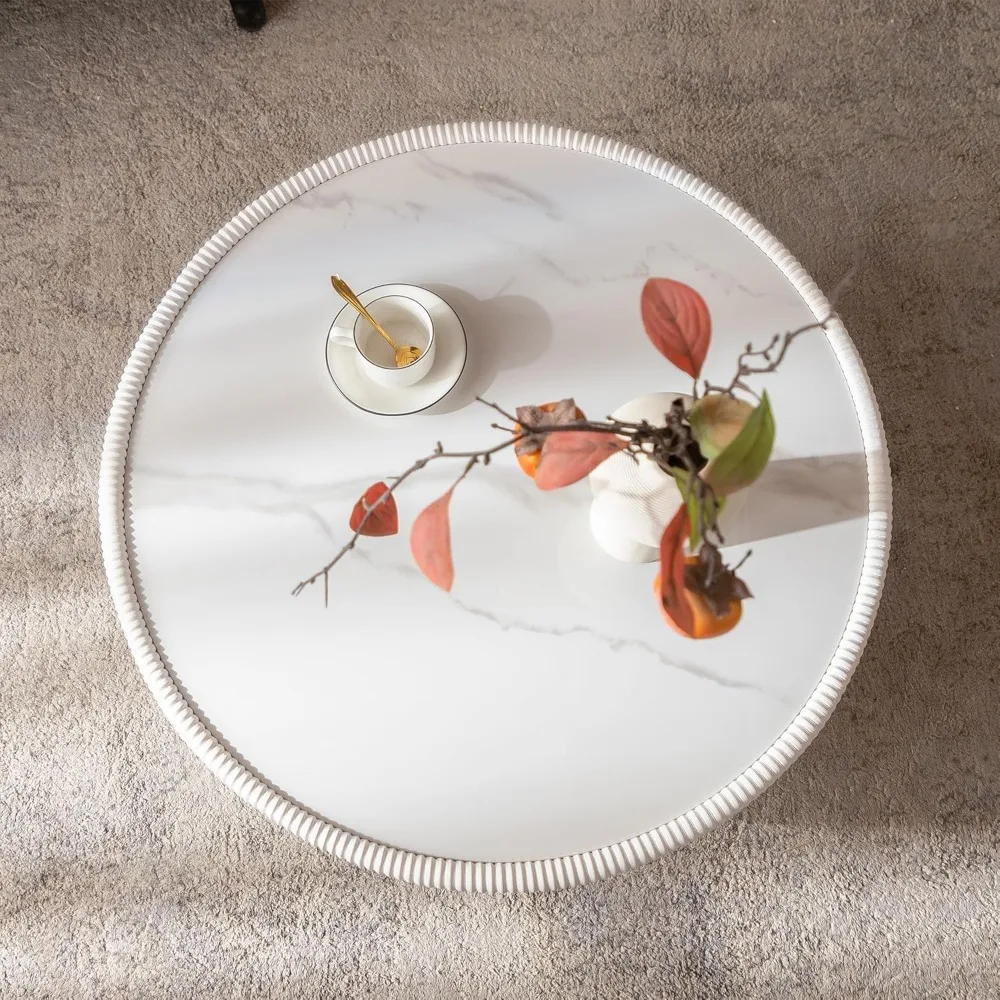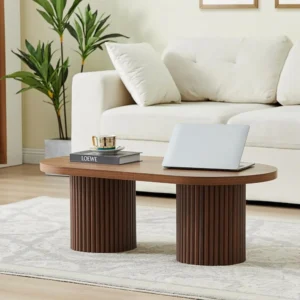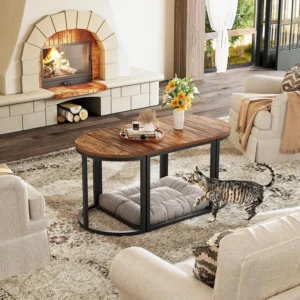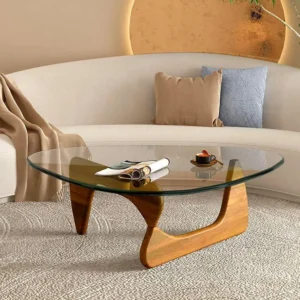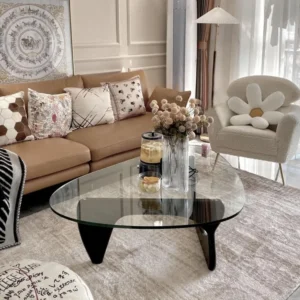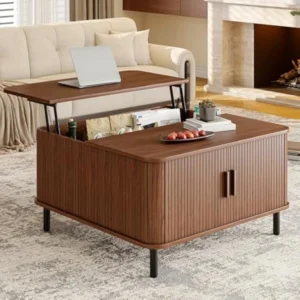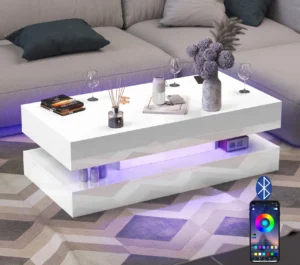Why Your Coffee Table Shape Matters More Than You Think
The coffee table is far more than a convenient spot for your remote control or coffee mug. It serves as the anchor for your entire living room, influencing everything from conversation flow to the visual balance of your space. Think about it – this piece of furniture often occupies the central area of your room, making it a true centerpiece that deserves careful consideration.
Different shapes create distinctly different psychological effects. Round tables foster inclusivity and connection, encouraging face-to-face interaction. Angular shapes like rectangles and squares, meanwhile, create structure and organization, defining the space with clear lines. These effects might seem subtle, but they profoundly impact how you and your guests feel in the room.
From a practical standpoint, your coffee table’s shape determines traffic flow around your seating area. The wrong shape can create awkward pathways or make certain seats difficult to access, while the right one enhances functionality and movement. Understanding these latest trends in oval coffee tables and other shapes can help you make informed decisions.
Beyond psychology and practicality, shape plays a crucial role in design harmony. Your coffee table either complements or contrasts with your other furniture, contributing to the overall visual story of your space. The perfect shape creates balance, while the wrong one can make even the most beautiful room feel somehow “off.”
The Perfect Match: Coffee Table Shapes for Different Sofa Types
Finding harmony between your coffee table and sofa is essential for creating a cohesive living space. Your sofa, as the largest piece of furniture in most living rooms, demands a coffee table that complements its proportions and shape.
Standard Straight Sofas
For traditional straight sofas, rectangular coffee tables create a natural symmetry by echoing the sofa’s linear shape. This pairing provides maximum functional surface area directly in front of seated guests. For visual interest, consider a round or oval table instead, which softens the room’s overall appearance and creates a pleasing contrast to the straight lines of the sofa.
Sectional Sofas
L-shaped sectionals present a unique challenge. A square coffee table can fill the corner space efficiently, providing equal access to both sides of the sectional. Alternatively, a round table softens the angular nature of the sectional. For larger U-shaped sectionals, consider either a large round table at the center or a substantial rectangular piece that provides accessibility from all seating positions.
The relationship between coffee tables for large sectional sofas requires special attention to scale. An oversized sectional demands a substantial coffee table that won’t appear dwarfed in comparison.
The Balance Principle
The visual weight of your table should balance with your sofa without dominating it. Think in terms of complementary shapes: pairing a linear sofa with a round or oval table creates visual interest, while matching shapes (rectangular sofa with rectangular table) creates cohesive harmony.
Remember that proportion matters as much as shape. A good rule of thumb is that your coffee table should be approximately two-thirds the length of your sofa, regardless of the shapes involved. This creates a pleasing visual balance that anchors your seating arrangement.
Round Coffee Tables: The Social Circles
Round coffee tables naturally facilitate conversation by creating an inclusive atmosphere where everyone feels connected. Their circular shape symbolically brings people together, encouraging eye contact and interaction in a way that corners and edges simply cannot. This makes them ideal for social spaces where conversation is a priority.
One of the most practical benefits of round coffee tables is their safety. With no sharp corners to bump into, they’re the perfect choice for households with small children, elderly family members, or simply those who prefer worry-free navigation around their living space. This safety feature doesn’t sacrifice style – round tables can be just as sophisticated as their angular counterparts.
Round tables also excel at improving traffic flow. Their shape naturally allows for smoother movement around the living space, as people can gently curve around them rather than making sharp turns to avoid corners. This creates a more fluid, harmonious movement pattern throughout the room.
When selecting a round coffee table, consider these key factors:
- For smaller spaces, a diameter of 30-36 inches typically works well
- Larger rooms can accommodate tables up to 48 inches in diameter
- Allow at least 18 inches between the table edge and surrounding furniture
- Consider table height in relation to your sofa (typically 1-2 inches lower than the seat cushions)
Our mid-century modern round coffee tables showcase how this shape works beautifully with both contemporary and classic design aesthetics. The circular form creates a sense of continuity that can soften more structured room designs, while still providing substantial functionality.
Rectangular Coffee Tables: The Classic Choice
Rectangular coffee tables remain the most popular choice for good reason – they’re incredibly versatile and practical. Their classic proportions work well with most sofa styles, particularly traditional straight sofas where they create a natural, harmonious pairing. The familiar shape feels comfortable and expected, making it a safe choice for nearly any living room.
The greatest advantage of rectangular tables is their functional surface area. They typically provide the maximum usable space for everything from coffee table books to game nights with the family. The straight edges also make it easier to divide the surface into distinct zones for different purposes – perhaps one area for decorative elements and another kept clear for daily use.
For proper proportions, consider these guidelines:
- Length should be approximately two-thirds the length of your sofa
- Width typically ranges from 18-30 inches, depending on your space
- Allow 18 inches of space between the table and surrounding seating
- Ensure pathways around the table maintain at least 30 inches for comfortable movement
Rectangular tables bring a sense of order and structure to a room. Their clean lines help define the space, creating clear boundaries and a sense of organization that many find appealing. This shape also typically offers more storage options, with many rectangular models featuring shelves, drawers, or hidden compartments.
Our mid-century modern rectangular coffee tables combine this practical shape with distinctive design elements that elevate them beyond the ordinary. While rectangular tables may be common, the right design ensures yours will be anything but basic.

Square Coffee Tables: Perfect Balance for Symmetrical Spaces
Square coffee tables create a sense of stability and balance that’s immediately apparent in any room. Their equal proportions bring a pleasing symmetry that can anchor your space, particularly in room layouts that are themselves square or feature furniture arranged in a balanced, symmetrical pattern.
These tables truly shine in conversation areas where seating surrounds all four sides. Unlike rectangular tables that favor the longer sides, square tables provide equal access from all directions. This democratic quality makes them perfect for spaces where multiple conversation groupings might form or where you want to encourage interaction from all sides.
When selecting a square coffee table, consider these points:
- For optimal proportion, the width should be about two-thirds the length of your sofa
- Standard sizes range from 30-40 inches square, but custom sizes can work for unique spaces
- Ensure at least 18 inches of clearance between the table edges and surrounding furniture
- In smaller rooms, consider a slightly raised design with visible legs to create a sense of airiness
Square tables make a bold, modern statement in many design contexts. Their geometric precision feels intentional and curated, especially when paired with softer elements like a plush sofa or rounded accent chairs. This juxtaposition of forms creates visual interest and demonstrates thoughtful design consideration.
For rooms that feature strong architectural elements like square windows or recessed ceiling details, a square coffee table can reinforce these features, creating a cohesive design language throughout the space. Our mid-century modern square coffee tables complement these spaces perfectly with their balanced proportions and clean lines.
Oval Coffee Tables: The Sophisticated Compromise
Oval coffee tables offer an elegant middle ground between the flowing curves of round tables and the practical surface area of rectangular ones. This hybrid quality makes them exceptionally versatile and suitable for a wide range of interior styles, from traditional to contemporary.
The soft edges of oval tables create a welcoming visual effect while still providing ample surface area for books, drinks, and decorative objects. Their curved perimeter promotes smooth movement around the room, eliminating the hazard of sharp corners while maintaining a substantial presence in your space.
One of the oval table’s greatest strengths is its ability to visually lengthen a room. Placed with the longer dimension parallel to your sofa, an oval table can make a space appear more expansive than it actually is – a valuable trick for smaller living rooms or narrow spaces.
These tables are remarkably adaptable to different furniture arrangements:
- They pair beautifully with curved or rounded sofas, echoing their organic lines
- They provide a softening counterpoint to angular sectionals and square chairs
- They work particularly well with conversation areas that aren’t strictly rectangular
When deciding between oval vs rectangular coffee tables, consider how the oval’s flowing lines guide the eye around your space, creating a sense of movement and grace that rectangular tables simply can’t match.
For a sophisticated statement that balances practicality with elegant design, explore our collection of mid-century modern oval coffee tables. These pieces demonstrate how the oval form has remained a designer favorite through decades of changing interior trends.
Freeform and Organic Coffee Tables: Statement Pieces With Character

For those who view furniture as art, freeform and organic coffee tables offer unparalleled creative expression. These unconventional pieces break free from geometric constraints, featuring natural, flowing lines or asymmetrical shapes that immediately draw attention and spark conversation.
Organic coffee tables often take inspiration from nature—resembling river stones, tree slices, or abstract natural forms. This connection to the natural world brings a refreshing element into homes that might otherwise feature primarily manufactured, geometric shapes. The biophilic design principle suggests that these nature-inspired forms actually reduce stress and increase wellbeing in our living spaces.
These statement pieces do require special consideration:
- Allow ample space around irregular shapes for comfortable navigation
- Consider how the unique form will interact with other furniture pieces
- Ensure the unusual shape still provides functional surface area where needed
- Balance a dramatic table with simpler surrounding elements to avoid visual competition
The irregular nature of these tables makes them natural conversation starters. Guests will inevitably comment on a beautifully crafted freeform table, making it not just furniture but a social catalyst. The unique design features of oval-shaped tables and other organic forms can transform an ordinary room into a memorable space.
While bold, these tables aren’t just about aesthetics—they often incorporate remarkable craftsmanship and materials. Live-edge wood, sculpted glass, or hand-formed metal showcase the artistry that goes into creating these one-of-a-kind pieces, adding another dimension of appreciation beyond mere shape.
Essential Size and Placement Rules for Any Coffee Table Shape
Regardless of which shape you ultimately choose, certain universal principles ensure your coffee table will function beautifully in your space. These time-tested rules provide a framework for making confident decisions:
The Two-Thirds Rule: Your coffee table should be approximately two-thirds the length of your sofa for visual balance. For instance, a 96-inch sofa would pair well with a 64-inch table.
Height Harmony: The ideal coffee table sits at or just below your sofa’s seat height—typically 16-18 inches from the floor. This ensures comfortable access from a seated position.
Clearance Requirements: Maintain about 18 inches between your coffee table and seating furniture. This provides comfortable leg room while keeping the table within easy reach. For walkways around the table, aim for at least 30 inches of clearance.
Centering Principles: In most arrangements, the coffee table should be centered in front of the sofa. In L-shaped sectionals, position it to serve both sides equally, usually slightly closer to the corner of the sectional.
Scale Consideration: The visual weight of your table should match your room’s proportions. Bulkier furniture requires a substantial coffee table, while more delicate furniture pairs better with lighter-looking tables.
When selecting the best shape coffee table for small spaces, these rules become even more crucial. In compact areas, maintaining proper clearances while maximizing functionality often means choosing space-efficient shapes like rounds or ovals.
Remember that while these guidelines provide a strong foundation, they can be thoughtfully adjusted to accommodate unique spaces or specific needs. The ultimate goal is a balanced, functional arrangement that serves your lifestyle.
How Room Size Influences Your Ideal Coffee Table Shape
Your room’s dimensions play a critical role in determining the most suitable coffee table shape. Different spaces present different challenges and opportunities that should guide your selection.
In small spaces, round and oval tables shine by eliminating sharp corners that interrupt traffic flow. Their curved edges create a sense of continuity that makes tight areas feel more navigable. A 30-36 inch round table can serve a compact seating area without overwhelming it, while an oval table provides more surface area without requiring additional floor space.
Conversely, large or open-concept spaces can easily accommodate substantial rectangular or square tables. These bold geometric shapes help define conversation areas within expansive rooms, essentially creating a “room within a room.” In generous spaces, consider tables 48 inches or longer to maintain proper scale with your architecture.
Narrow rooms present special challenges. Here, oval or narrow rectangular tables prove most effective by leaving adequate walkways on either side. The elongated form of these tables ensures functionality without creating cramped pathways.
The shape of your room should often influence your table choice:
- Square rooms: Square tables reinforce the room’s proportions
- Rectangular rooms: Rectangular or oval tables that echo the room’s longer dimension
- Irregular rooms: Freeform or round tables that don’t emphasize any particular axis
Learning how to perfectly style an oval coffee table or other shapes can further enhance your room’s proportions by drawing attention to its best features while minimizing challenging aspects.
Beyond Shape: Material Considerations for Your Coffee Table
The material of your coffee table works in concert with its shape to determine its overall impact in your space. Different materials can dramatically alter how a particular shape reads in your room:
Glass creates visual lightness with any shape, making it particularly valuable in smaller spaces or rooms that already contain substantial furniture. A glass-topped round table appears to float, while a rectangular glass piece maintains clean lines without visual heaviness. Glass also allows visibility of beautiful rugs or flooring beneath.
Solid Wood brings warmth and natural character to geometric shapes. The material’s substantial nature makes it ideal for larger rooms where a coffee table needs presence to balance other elements. Wood rectangular tables often become central, grounding elements in a room.
Metal frames or components add a contemporary edge to any shape. Metal-framed round tables feel more architectural, while metal bases can make substantial rectangular tables appear lighter.
Stone tops (marble, granite, concrete) add sophistication and durability to coffee tables. The natural variations in stone bring visual interest to simple shapes like rounds or rectangles.
Different materials also affect maintenance requirements:
- Glass requires regular cleaning to maintain its sparkling appearance
- Wood needs occasional polishing and protection from moisture
- Metal may need periodic treatment to prevent tarnishing or oxidation
- Stone may require sealing to prevent staining
Our mid-century modern glass-top coffee tables demonstrate how material choice can transform the same basic shape into dramatically different design statements.
Mid-Century Modern Danish Coffee Tables, Mid-Century Modern Oval Coffee Tables, Mid-Century Modern Solid Wood Coffee Tables
$390.05 Select options This product has multiple variants. The options may be chosen on the product pageMid-Century Modern Coffee & End Table Sets, Mid-Century Modern Coffee Table Sets, Mid-Century Modern Oval Coffee Tables
Price range: $257.48 through $331.04 Select options This product has multiple variants. The options may be chosen on the product pageMid-Century Modern Glass Top Coffee Tables, Mid-Century Modern Glass Top Side & End Tables
$460.58 Select options This product has multiple variants. The options may be chosen on the product pageMid-Century Modern Glass Top Coffee Tables, Mid-Century Modern Vintage Coffee Tables, Mid-Century Modern Vintage Side & End Tables
$725.36 Select options This product has multiple variants. The options may be chosen on the product pageMid-Century Modern Lift Top Coffee Tables, Mid-Century Modern Square Coffee Tables
$454.73 Select options This product has multiple variants. The options may be chosen on the product pageMid-Century Modern Large Coffee Tables, Mid-Century Modern Rectangular Coffee Tables
$603.26 Select options This product has multiple variants. The options may be chosen on the product page
Bridging Sectionals: Special Considerations for Curved Furniture
Curved sectionals and sofas present unique challenges for coffee table selection. Their non-linear form requires thoughtful consideration to create both visual harmony and functional access.
For gently curved sectionals, an oval coffee table often provides the ideal solution. The table’s elongated curve can mirror the sofa’s arc, creating a cohesive flow while ensuring all seated positions have reasonable access to the table surface. The enhanced room flow of oval coffee tables makes them particularly suitable for these curved arrangements.
In cases of dramatically curved sectionals, consider these approaches:
- Custom curved tables that precisely follow your furniture’s contour
- A cluster of smaller tables (perhaps rounds in varying sizes) that collectively serve the entire sectional
- A central round table with supplementary side tables at key positions
Access points become particularly important with curved furniture. Ensure that pathways into and out of the seating area remain clear and that the table arrangement doesn’t create awkward dead zones where movement is difficult.
For deeply curved conversation pits or U-shaped sectionals, a central round table often proves most effective, as it provides equal access from all angles while its curved shape echoes the surrounding furniture. This creates a satisfying visual relationship that feels intentional rather than forced.
Is One Coffee Table Enough? Nesting Tables and Table Groups

While traditional design often focuses on a single coffee table, contemporary approaches frequently incorporate multiple tables for enhanced flexibility and visual interest. Nesting tables and coordinated table groups offer practical advantages worth considering.
Nesting tables provide remarkable adaptability. When not needed, they tuck neatly together, conserving space. When entertaining, they can be dispersed to serve different seating areas, ensuring drinks and snacks are within everyone’s reach. Their varying heights create visual dimension, while their ability to separate and regroup offers practical versatility for changing needs.
Benefits of multiple table arrangements include:
- Enhanced flexibility for different activities and gatherings
- More equitable access from various seating positions
- Visual dynamism through varying heights and overlapping shapes
- The ability to reconfigure your space without major furniture moves
Consider these arrangements particularly valuable for:
– Large sectionals where a single table can’t reasonably serve all seats
– Rooms that serve multiple functions and need adaptable furniture
– Spaces where entertaining regularly requires additional surface area
Our collection of mid-century modern nesting coffee tables showcases how these flexible pieces can solve practical challenges while adding sophistication to your living space.
When using multiple tables, maintain a sense of cohesion through consistent materials, complementary shapes, or a unified design language. This ensures the arrangement feels intentional rather than haphazard.
Safety First: Kid and Pet-Friendly Coffee Table Shapes
For households with children or pets, safety considerations may ultimately override pure aesthetic preferences when selecting a coffee table shape. Thoughtful choices here prevent injuries while still maintaining style.
Round and oval tables are universally recognized as the safest options for families with young children. Their smooth, continuous edges eliminate the risk of injuries from sharp corners—a significant concern during the toddling years when falls are common and eye level often aligns with table corners.
For those who prefer the look of rectangular or square tables but need safer options, consider:
- Tables with rounded corners that maintain a generally rectangular shape
- Soft upholstered ottomans that double as coffee tables
- Tables with padded edges or specialized corner protectors
- Tables with slightly inset tops where the corners don’t extend to the outer edge
Pet considerations also matter, particularly for active dogs who may race through living spaces. Lower profile tables reduce the risk of tail injuries, while stable, heavy designs prevent tipping if pets jump up or bump the table.
Regardless of shape, ensure any coffee table in a family home is sturdy and stable. Avoid designs with delicate legs that could snap under unexpected weight, glass components that could shatter, or lightweight pieces that might tip easily.
Frequently Asked Questions About Coffee Table Shapes
What shape coffee table works best with a sectional sofa?
For L-shaped sectionals, square or rectangular tables typically work best in the corner area. Round tables can soften the angular look of sectionals while providing equal access from both sides. For curved sectionals, oval tables that echo the curve create the most harmonious appearance.
Should coffee tables match other tables in the room?
Rather than exact matching, aim for complementary relationships. Your coffee table can coordinate with other tables through shared materials, similar design language, or complementary shapes. This creates cohesion without the matchy-matchy look that can feel dated.
Can I use multiple coffee tables instead of one?
Absolutely! Multiple smaller tables offer flexibility for different activities and seating arrangements. This approach works particularly well in larger rooms or with extensive seating where one table can’t serve everyone comfortably.
What shape makes a small room look bigger?
Round and oval tables create a sense of space in small rooms by eliminating hard corners that visually segment the area. Glass tops also help by maintaining visual flow and allowing light to pass through, reducing visual weight.
Which shapes offer the most functional surface area?
Rectangular tables typically provide the most usable surface area for their footprint. Square tables offer substantial space as well, while round and oval tables sacrifice some functional area in exchange for improved flow and safety.
The extensive variety of mid-century oval coffee tables in modern design demonstrates how different shapes can be adapted to various functional needs while maintaining distinctive style.
Making Your Final Decision: Balancing Form, Function and Personal Style
After considering the various factors that influence coffee table shape selection, remember that the perfect choice ultimately balances practical requirements with your personal aesthetic preferences.
Start by honestly assessing your primary needs: Do you entertain frequently? Do you have young children? Is your space compact or expansive? These practical considerations create a foundation for your decision. A beautiful table that doesn’t serve your daily needs will quickly become a frustration rather than a joy.
Next, consider the visual dialogue between your coffee table and existing furniture. The right shape either complements or intentionally contrasts with your other pieces, creating a thoughtful design statement. This relationship—whether harmonious or deliberately juxtaposed—elevates your entire room design.
Finally, trust your personal taste. While design principles provide valuable guidance, your home should reflect your unique sensibilities. If you’re consistently drawn to a particular shape despite it not being the “recommended” option for your space, explore how you might make it work. Often, slight adjustments in placement or surrounding elements can accommodate your preferred shape.
Remember that at Hearth Forms, we believe the best coffee table isn’t simply the one that follows design rules—it’s the one that makes you feel at home in your space while serving your lifestyle needs beautifully. The perfect coffee table shape exists at the intersection of function, form, and your personal design story.

